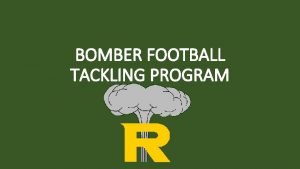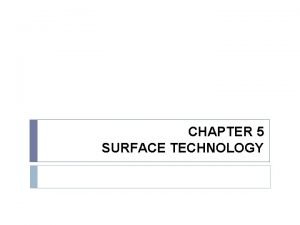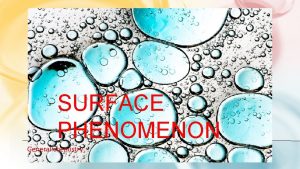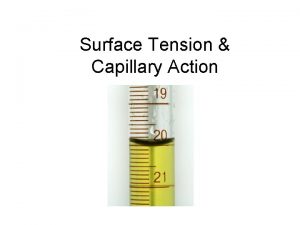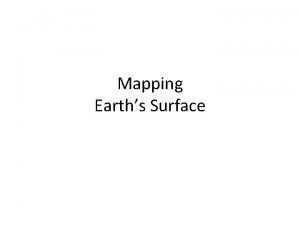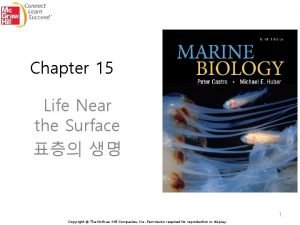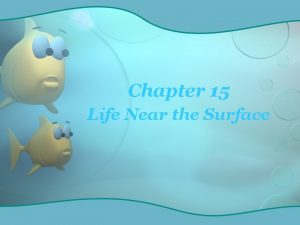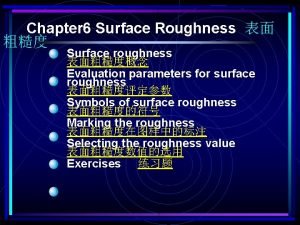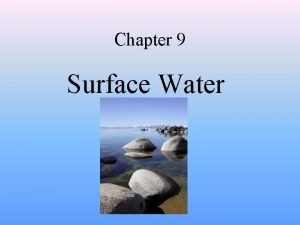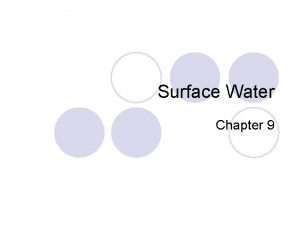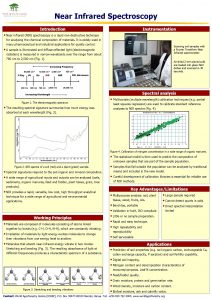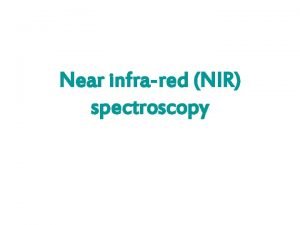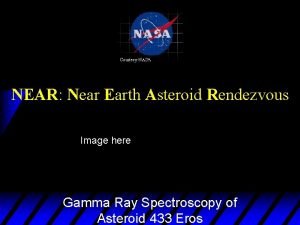Chapter 15 Life Near the Surface Life Near





































- Slides: 37

Chapter 15 Life Near the Surface

Life Near the Surface • Pelagic – water column away from bottom or shore • Epipelagic – sea surface to depth of about 200 meters – The epipelagic can be divided into (1) neritic waters over the continental shelf and (2) oceanic waters that are not over the continental shelf


Life Near the Surface • Epipelagic oceanic ecosystems: – Warmest portion of the water column – Most well lit portion of the water column (light can be limiting in high latitudes and at night, however) – There are vast stretches of water that support primary production – This primary production support organisms in this community as well as organisms in other communities via water currents

Life Near the Surface • Disadvantages of the Epipelagic oceanic ecosystem: – No substrate for attachment – No bottom for burrowing or deposit feeding – Places to hide from predators are extremely limited and prey often can spot predators

Life Near the Surface • Plankton: – Thrive in the epipelagic – Plankton are organisms that cannot fight against the prevailing water currents – These organisms may be microscopic or not – Plankton are classified in numerous ways including by size, by trophic status and by the length of time spent in the plankton

Plankton Division by Size (Know Net)

Plankton Division by Time in the Plankton • Holoplankton – • the entire life of the organism is spent in the plankton Meroplankton – spend only a portion of their life as plankton (larvae of molluscs (a), brittlestars (b), sea stars (c), polychaetes (d) crustaceans(e) and fish

Plankton Classification by Trophic Status • Phytoplankton – plankton that generate energy by means of primary production (autotrophs)=cyanobacteria, diatoms, dinoflagellates, green algae, red algae, brown algae • Zooplankton – plankton that are heterotrophs=ciliates, radiolarians, foramniferans, copepods, tunicates, pteropods (gastropod) and larvae

Phytoplankton • Diatoms – Mainly reproduce by _____ (a form of asexual reproduction) – Extremely important primary producers – Common in all marine waters – May be solitary cells or a colony of cells – Can be pennate (elongate) or centric (circular)

Phytoplankton • Dinoflagellates – Each of the 1200 species has unique shape reinforced by plates of cellulose – Two _____ in grooves on body that produce spinning motion – Also reproduce by cellular division – Some are bioluminescent – Some are toxic such as the species that cause ____ Tide or Pfiesteria – they are particularly prevalent in warm waters and “bloom” readily when nutrients are plentiful

Phytoplankton • Cyanobacteria – Some can go through nitrogen fixation which improves growth in low nutrient conditions – Also an extremely important primary producer – Many grow in filamentous colonies with other cyanobacterial cells – Other are solitary cells

Zooplankton • Copepods – Small crustaceans – Dominate the zooplankton, perhaps making up to 70% of zooplankton – Copepods feed on phytoplankton as well as other zooplankton – They, in turn, serve as a major source of food for other organisms

Zooplankton • Other zooplankton include a variety of ciliates and other protists that move by way of pseudopods such as foraminiferans and radiolarians.

Foramniferan catching a copepod in its long, thin pseudopods

Zooplankton-Tunicates • (Salps (top right) and larvaceans (bottom right)) are pelagic tunicates that can utilize mucous nets to capture food particles

Zooplankton • Pteropods are planktonic • • • molluscs (gastropods) The foot is modified into two parts that serve as “wings” used for swimming Can be found in epipelagic or deeper waters Eat phytoplankton and other zooplankton

Zooplankton • Jellyfish and comb jellies are not small organisms • However, they are considered by some biologists to be plankton because they cannot fight the prevailing water currents in most cases • Both organisms are carnivorous

Life in the Epipelagic • Living in this environment means finding ways to STAY AFLOAT • This can be accomplished in various ways including air or lipid filled compartments (increases buoyancy) or by increasing surface area and “drag”

Increasing Drag and Surface Area • Some organisms • • increase their surface area by being flat (as seen top right) Others have a variety of spines or appendages to increase their surface area (bottom right) In both cases, increasing the surface area promotes “drag” or water resistance which helps keep these organisms afloat

Increasing Buoyancy • Some organisms increase buoyancy by containing droplets or compartments of lipid which tends to float • Lipids are used in this way by diatoms, copepods and many larval forms • Other organisms trap air in various structures or compartments to increase buoyancy • Such organisms include cyanobacteria, cnidarians and even fish (swim bladder)

Nekton • Nekton are organisms that can fight against the prevailing water current and purposefully move in any direction they choose • Examples of nekton found in the pelagic zone are fish, sea turtles and sea snakes, marine mammals, cephalopods, and some larger crustaceans.

Predation and Protection from Predation • Since organisms have virtually no places to hide, they must have other means for finding prey or avoiding being prey • Fast swimming, protective coloration, migrations and a variety of sense organs are used to accomplish this

Sense Organs • Eyes – – eyes can be used to form images or simply to sense light/dark or patterns – Most organisms is this environment have well developed eyes – Eyesight is used to capture prey, avoid being prey, find mates and stay in groups (as applicable)

Sense Organs – Remote Sensing • Both cartilaginous and bony fish have a _____ line for remote sensing of water movement that can indicate prey or predators are nearby

Sense Organs – Remote Sensing • Dolphins and other cetaceans use their _____ for echolocation to navigate pelagic waters • They also use the melon to find prey and avoid predators

Protective Coloration • To blend in with their environment, organisms can have different types of protective coloration: – Countershading – Camouflage – Transparency

Countershading • In _____ organisms, the • • ventral side of the organism is lighter than the dorsal side This aids the organism in “blending in” because if they are seen from above, their darker dorsal side blends in with the darker water below However, if they are seen from below, their lighter ventral side blends in with the better lit water above

Camouflage • As an example, the sargassum fish, Histrio histrio, is an • example of a pelagic organism that uses camouflage for protection from predators This fish looks very much like the Sargassum macroalgae it calls home

Transparency • Another way to hide is to lack coloration completely • This is the case with most jellyfish, comb jellies, and pelagic tunicates, as well as many zoo- and phytoplankton

Swimming • Epipelagic predators must be able to swim quickly to • capture prey This is accomplished by a streamlined body to reduce drag and a strongly forked caudal tail to increase thrust.


Pelagic Food Webs • The diagram to • the right shows one example of a food web and how the web changes over the life cycle of one species This is a common feature of pelagic food webs – an organism will not feed on the same type of organisms throughout their life

Where do the Food Webs Begin? • All pelagic food webs begin with either phytoplankton, either directly or as dissolved organic matter (DOM), which comes from viral action.

Limitations to Primary Productivity • Primary production can be limited by light – even though there is normally plenty of light in the pelagic environment, light is not present at night or for long stretches in high latitudes at certain times of the year

Limitations to Primary Productivity • Primary production can also be limited by essential nutrients such as nitrogen (most important) or phosphate • Bacteria are important “recyclers” of these nutrients as they break down organic matter and cyanobacteria fix nitrogen

Areas of Upwelling • The heating and • • • cooling of surface waters can cause deeper water to be brought to the surface in certain areas The diagram to the right shows this process, called upwelling Upwelling brings vital nutrients to the surface (these nutrients were lost from the pelagic as DOM, fecal matter, and mucous) Primary production is higher in areas of upwelling
 Near foot near shoulder tackling
Near foot near shoulder tackling Lateral surface area of the prism
Lateral surface area of the prism Spin coat
Spin coat Wet curved surface area
Wet curved surface area Chapter 9 surface water chapter assessment answer key
Chapter 9 surface water chapter assessment answer key Hình ảnh bộ gõ cơ thể búng tay
Hình ảnh bộ gõ cơ thể búng tay Ng-html
Ng-html Bổ thể
Bổ thể Tỉ lệ cơ thể trẻ em
Tỉ lệ cơ thể trẻ em Voi kéo gỗ như thế nào
Voi kéo gỗ như thế nào Tư thế worms-breton
Tư thế worms-breton Bài hát chúa yêu trần thế alleluia
Bài hát chúa yêu trần thế alleluia Các môn thể thao bắt đầu bằng từ đua
Các môn thể thao bắt đầu bằng từ đua Thế nào là hệ số cao nhất
Thế nào là hệ số cao nhất Các châu lục và đại dương trên thế giới
Các châu lục và đại dương trên thế giới Công thức tính thế năng
Công thức tính thế năng Trời xanh đây là của chúng ta thể thơ
Trời xanh đây là của chúng ta thể thơ Cách giải mật thư tọa độ
Cách giải mật thư tọa độ Phép trừ bù
Phép trừ bù Phản ứng thế ankan
Phản ứng thế ankan Các châu lục và đại dương trên thế giới
Các châu lục và đại dương trên thế giới Thơ thất ngôn tứ tuyệt đường luật
Thơ thất ngôn tứ tuyệt đường luật Quá trình desamine hóa có thể tạo ra
Quá trình desamine hóa có thể tạo ra Một số thể thơ truyền thống
Một số thể thơ truyền thống Cái miệng nó xinh thế
Cái miệng nó xinh thế Vẽ hình chiếu vuông góc của vật thể sau
Vẽ hình chiếu vuông góc của vật thể sau Thế nào là sự mỏi cơ
Thế nào là sự mỏi cơ đặc điểm cơ thể của người tối cổ
đặc điểm cơ thể của người tối cổ Thứ tự các dấu thăng giáng ở hóa biểu
Thứ tự các dấu thăng giáng ở hóa biểu Vẽ hình chiếu đứng bằng cạnh của vật thể
Vẽ hình chiếu đứng bằng cạnh của vật thể Fecboak
Fecboak Thẻ vin
Thẻ vin đại từ thay thế
đại từ thay thế điện thế nghỉ
điện thế nghỉ Tư thế ngồi viết
Tư thế ngồi viết Diễn thế sinh thái là
Diễn thế sinh thái là Dot
Dot Các số nguyên tố là gì
Các số nguyên tố là gì
